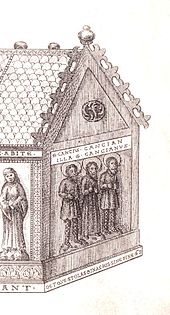Cantius, Cantianus and Cantianilla

Cantius, Cantianus and Cantianilla , German also Kanzius, Kanzian and Kanzianilla , (perhaps † 304 at Aquileia ) are the traditional names of three siblings and martyrs of the Diocletian persecution of Christians . Their veneration emanated from Aquileia and spread across large parts of Europe. Their historical individuality cannot be determined.
Legend
Venantius Fortunatus († around 600), Bishop of Poitiers and a native of Treviso , notes in his poem on St. Martin :
- Aquileiensem si fortasse accesseris urbem Cantianos Domini nimium venereris amicos.
- "Should you come to Aquileia, pay the greatest devotion to the Cantiani, the friends of the Lord."
It is the testimony to a martyr cult that was already known at the time and which, because of the dignity of the Patriarchate of Aquileia , penetrated the Alps. The three names can be found in the Martyrologium Romanum and several times in the Hieronymianum . Maximus von Turin († around 420) mentions in a sermon that the siblings were killed in front of the city of Aquileia when they wanted to escape from there in a carriage.
This motif was obviously the starting point for the medieval legend . After that, Cantius, Cantianus and Cantianilla came from the Roman city nobility , the gens Anicia , and were relatives of Emperor Carinus . When the Diocletian persecution began, they released their 73 slaves after they had been instructed in the Christian faith and baptized, sold their property in Rome and went to Aquileia with their teacher Protus , where they also owned property; there they wanted to meet Bishop Chrysogonus . But there was also persecution in Aquileia. Chrysogonus was executed a month before the siblings arrived in Aquae Gradatae , 15 kilometers from Aquileia. Cantius and his companions now visited the Christians in the prisons, encouraged them, preached the gospel and performed many miracles. When they were quoted in court, they refused, citing their relatives to Emperor Carinus and demanding a verdict with the imperial signature. Then they went to the tomb of Chrysogonus at Aquae Gradatae. There the governor Sisinnius caught up with her and had her decapitated after her renewed refusal to sacrifice to the Roman gods. The priest Zeno buried her next to the tomb of Chrysogonus. The place and its church are now called San Canzian d'Isonzo .
Devotion and patronage
The relics of the martyrs are venerated in the Basilica of Aquileia , the Basilica of Grado and San Canzian d'Isonzo. a. in Milan Cathedral and in Hildesheim Cathedral , where they are kept with the relics of other cathedral patrons in the Romanesque Epiphanius shrine.
Soon after the year 1000 , the French King Robert II brought relics of the three martyrs from Milan to Étampes in what is now the Essonne department , where they were kept in the abbey church of Notre-Dame-du-Fort and venerated twice a year with a festival procession. Part of it also came to the Cathedral of Sens , to whose historical diocese Étampes belonged (formerly its own office ).
Numerous churches, especially in Friuli and the neighboring areas of Austria , Slovenia and Croatia, bear the patronage of the three martyr siblings, see Kanzian Church .
literature
- Claudio Tiberio, Federico Leban: Il culto dei santi fratelli martiri Canziano, Canzio e Canzianilla , Arti Grafiche Friulane, 1989
Web links
- Ireneo Daniele: Santi Canzio, Canziano e Canzianilla Martiri (santiebeati.it, Italian)
